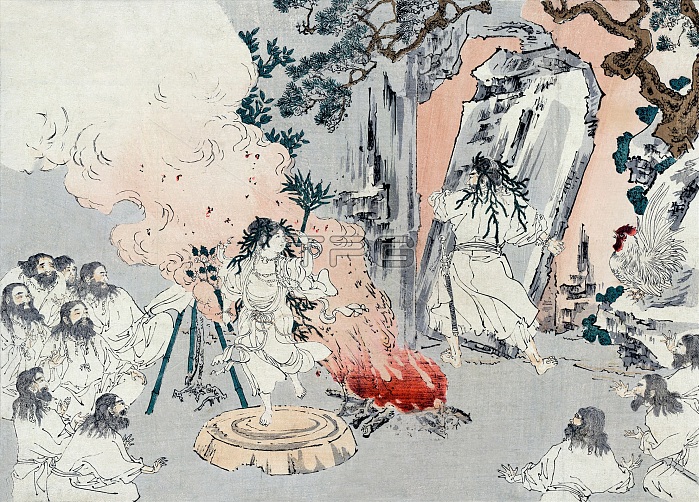
Entitled: "Ama no iwato"; shows a woman, possibly Countess Kami dancing on an overturned washtub with a group of gods facing her and a large fire behind her; in the background a warrior (Tajikara-o) moves the stone gate to the Ama no iwato cave. The purpose of the dance was to lure Amaterasu out of her heavenly cave so that the sun would again shine on the world. Ama-no-Iwato literally means "cave of the sun goddess" or "heavenly rock cave". In Japanese mythology as related in the Kojiki (Records of Ancient Matters), the bad behavior of Susano'o, the Japanese god of storms, drove his sister Amaterasu into the Ame-no-Iwato cave. The land was thus deprived of light. In order to get Amaterasu out of the cave the other gods threw a party outside. The goddess Ame-no-Uzume-no-Mikoto performed a lewd dance, eliciting much laughter. Amaterasu grew curious about the source of such mirth and peeked out of the cave entrance. She became fascinated by her own reflection in the Yata no Kagami mirror which the other gods had crafted and hung before the cave for that purpose, and stood transfixed. Ame-no-tajikarao then forced the cave open and the world was bathed in light once again. As Amaterasu stepped out of the cave a holy seal was applied to it so that she could never go back into hiding. No artist credited, circa 1880-1910.
| px | px | dpi | = | cm | x | cm | = | MB |
Details
Creative#:
TOP22172796
Source:
達志影像
Authorization Type:
RM
Release Information:
須由TPG 完整授權
Model Release:
N/A
Property Release:
No
Right to Privacy:
No
Same folder images:

 Loading
Loading